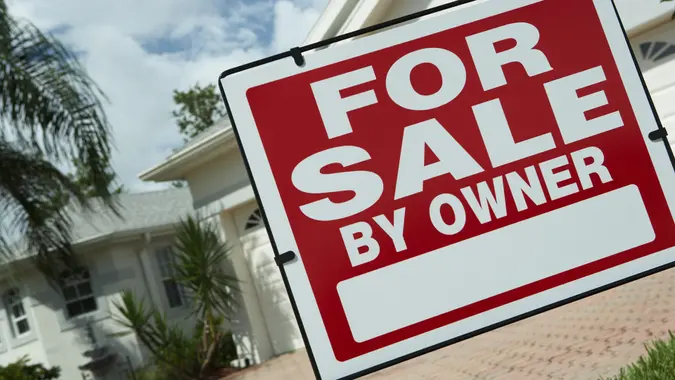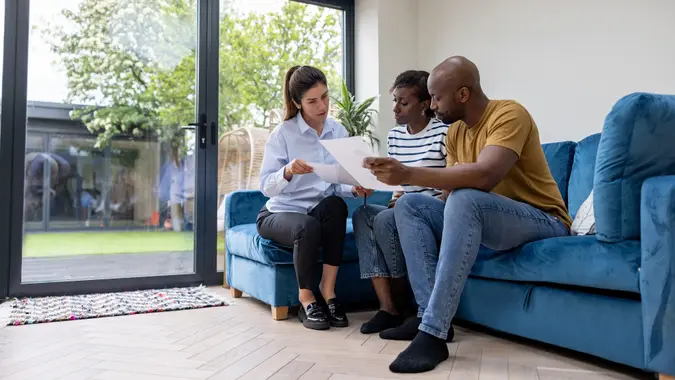What Is REO (Real Estate Owned) and How Does It Work?

Commitment to Our Readers
GOBankingRates' editorial team is committed to bringing you unbiased reviews and information. We use data-driven methodologies to evaluate financial products and services - our reviews and ratings are not influenced by advertisers. You can read more about our editorial guidelines and our products and services review methodology.

20 Years
Helping You Live Richer

Reviewed
by Experts

Trusted by
Millions of Readers
What is REO when it comes to real estate? It stands for real estate owned, and it’s a term you’ll see when a bank or lender takes ownership of a home after a failed foreclosure auction.
When a homeowner stops making mortgage payments and the property doesn’t sell at auction, the lender becomes the new owner. These homes are called REO properties, and they’re often sold below market value to recover the lender’s losses. For first-time homebuyers or real estate investors, REO homes can offer a rare opportunity to get more house for your money — if you’re willing to put in a little extra work.
Let’s break down how REO properties work, how they differ from foreclosures and what you should know before buying one.
What Does REO Mean and How Is It Different From a Foreclosure?
REO stands for real estate owned, and it refers to properties that banks or lenders have taken back after foreclosure. It’s the last stage in the foreclosure process.
Here’s the difference:
- Foreclosure: The lender begins legal proceedings to reclaim the property after missed payments.
- Auction: The property is put up for sale, usually at a public auction.
- REO: If no one buys the property at auction, it becomes real estate owned and the lender lists it for sale, often through a real estate agent or on a dedicated website.
In 2024, lenders repossessed over 35,000 homes through foreclosure — a 21% increase from the year before.
How Properties Become REO
Here’s a quick look at how a property becomes real estate owned:
- Missed payments: The homeowner defaults on the mortgage.
- Foreclosure: The lender begins the foreclosure process to reclaim the home.
- Auction: The property is offered at auction. If no one bids enough to cover the outstanding loan…
- REO status: The bank takes ownership and tries to sell the home directly.
Why Properties Don’t Sell at Auction
Several common reasons include:
- High starting bid from the bank
- The property is in disrepair
- Title or legal issues
- Lack of financing options for auction buyers
Pros and Cons of Buying REO Properties
Like any type of home purchase, buying an REO property comes with trade-offs. Here’s what to consider.
Benefits
- Lower price: Banks are motivated to sell and may price the home below market value.
- No unpaid property taxes: The lender clears liens and taxes before listing the property.
- Investor-friendly: These homes can be ideal for flipping or rental income.
Nearly 70% of REO properties sell for under $150,000, according to auction data from Auction.com.
Drawbacks
- Sold “as-is”: You’ll likely need to invest in repairs, sometimes major ones.
- Slower buying process: Working with a bank can mean delays.
- Tougher negotiation: Banks usually have strict price floors and limited wiggle room.
It’s worth noting, however, that over 60% of REO property purchases in 2023 were made by investors, not owner-occupants, which can make competition tough for regular homebuyers.
Quick Look: Pros and Cons of REO Homes
| Pros | Cons |
|---|---|
| Lower price | As-is condition |
| Investment opportunity | Slower closing process |
| No back taxes | Limited negotiation power |
| Clean title | Potential repair surprises |
How To Find REO Properties
If you’re ready to go REO shopping, here are some ways to find them:
- Bank websites: Many lenders, like Wells Fargo and Chase, list REO properties for sale.
- Real estate agents: Look for one who specializes in foreclosures or REO sales.
- Government programs: Sites like HUD.gov list REO homes from FHA, Fannie Mae and Freddie Mac.
REO inventory declined 10% year-over-year, indicating that banks are offloading distressed properties faster due to increased buyer demand. Might be worth striking while the iron is hot!
Steps To Buy a Real Estate Owned Property
Buying a real estate owned home is a bit different than buying from a regular seller. Here’s the process:
- Get pre-approved: This shows the bank you’re serious and ready to buy.
- Make your offer: Offers go through the bank’s REO department, not directly to a seller.
- Schedule an inspection: It’s critical since the home is sold “as-is.”
- Do your due diligence: Check the title, repair history and neighborhood comps.
- Close the deal: Expect a longer timeline compared to a traditional purchase.
Financing Options for REO Properties
REO homes can be purchased with financing, but some options work better than others:
- Conventional mortgage: Good for REOs in decent condition.
- FHA 203(k) loan: Lets you roll renovation costs into your mortgage — perfect for fixer-uppers.
- Cash: Ideal for investors or buyers looking to move quickly.
Cash buyers accounted for over 30% of all REO home purchases in 2023, according to CoreLogic.
Key Things To Consider Before Buying an REO Home
Before you dive in, ask yourself:
- What’s the condition? Have a contractor inspect if possible.
- What repairs are needed? Budget for at least 10% to 20% of the purchase price for potential repairs. Nearly 50% of REO homes require more than $10,000 in repairs, and some need much more depending on how long they’ve been vacant.
- Are there legal risks? Verify there are no lingering liens or disputes on the title.
- Is this a good deal? Compare nearby sales and rental comps if you’re investing.
Final Take to GO: Is Buying an REO Property Worth It?
Buying a real estate owned (REO) property can be a smart way to save money, especially if you’re open to repairs and willing to do your research.
But it’s not for everyone. These homes often need work, and the purchase process is slower than buying from a traditional seller. If you’re a first-time buyer or investor, REOs can offer solid value — but only if you go in prepared.
Next step: Check REO listings on lender and government sites, talk to an agent familiar with distressed properties and get pre-approved so you’re ready to make an offer when the right property appears.
FAQ
Here are the answers to some of the most frequently asked questions about REO and how it works:- Are REO properties cheaper than traditional homes?
- Yes, they’re often listed below market value to encourage a quick sale.
- Can I negotiate the price of an REO home?
- You can try, but banks are less flexible than private sellers. Lowball offers may be rejected outright.
- Do REO homes come with hidden costs?
- They can. Repair costs and delayed closings are the most common issues to watch for.
- How long does it take to buy an REO property?
- Expect 30 to 60 days or more. The process often involves extra layers of approval.
- What’s the difference between an REO and a short sale?
- An REO is already owned by the bank. A short sale is still owned by the homeowner but sold for less than the mortgage owed, with lender approval.
Data is accurate as of August 5, 2025, and is subject to change.
Our in-house research team and on-site financial experts work together to create content that’s accurate, impartial, and up to date. We fact-check every single statistic, quote and fact using trusted primary resources to make sure the information we provide is correct. You can learn more about GOBankingRates’ processes and standards in our editorial policy.
- ATTOM Data "Foreclosure Activity Continues Slow, Steady Climb Back to Normal Levels"
- Auction.com "A Shift in REO Auction Buyers"
- Housing Wire "CoreLogic: Fewer buyers paying cash for properties"
- This Old House "Should You Buy That Fixer-Upper? "
- REI Ink "U.S. FORECLOSURE ACTIVITY INCREASES QUARTERLY IN Q1 2024"
- National Neighborhood Indicators Partnership "NNIP Partners Explore Investor-Owned Housing"
- Clever Real Estate "Home Renovation Trends in 2024"
 Written by
Written by  Edited by
Edited by 
























